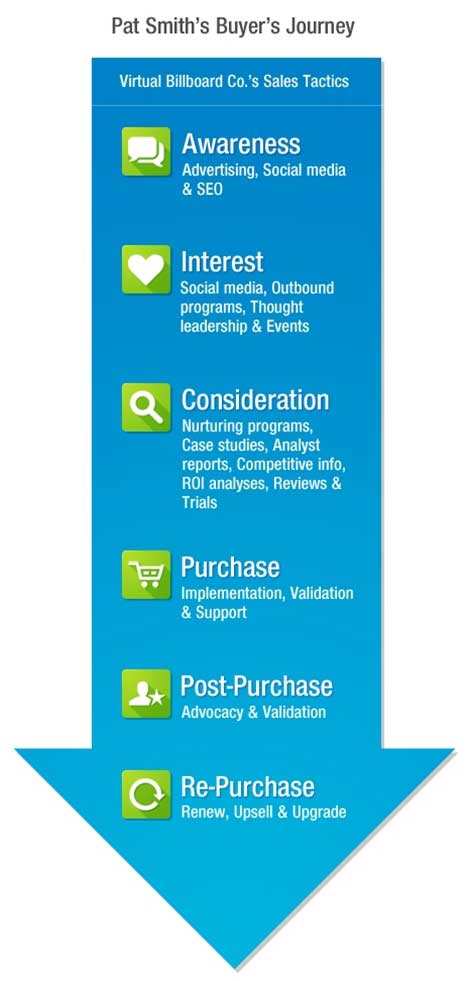Marketing automation serves many purposes, but its biggest advantage is in enabling marketers to tailor their activities to the customer's buying process—which has changed dramatically in the past few years.
These days, long before a prospective customer is receptive to connect with a salesperson, that buyer has been busy doing all kinds of Internet homework. Buyers educate themselves, refining their understanding of the problem they hope to solve. They read reviews, sit in on webinars, watch social media conversations, visit websites, and download whitepapers. In short, they control the process, forming opinions about which solutions and vendors can help them, all mostly on their own.
That doesn't mean marketers are cut out of helping to guide the buyer's journey. Interruption marketing doesn't work well anymore, true, but its place has been taken by engagement and nurturing, two strategies that foster interaction and trust between buyer and seller.
Marketing automation provides the structure that allows engagement and nurturing to be executed with relative precision, and at scale, via a marketing automation system.*
Nurturing, in particular, is a key win with automation, delivering quantifiable results:
- Businesses that use marketing automation to nurture prospects experience a 451% increase in qualified leads. (The Annuitas Group)
- Companies that excel at lead nurturing generate 50% more Sales-ready leads at 33% lower cost. (Forrester Research)
- Nurtured leads make 47% larger purchases than non-nurtured leads. (The Annuitas Group)
Lead scoring, another capability enabled by marketing automation, is the tactic of applying points to a customer's characteristics or behaviors. Lead scoring and lead nurturing work particularly well together, with implications far beyond the top of the funnel.
As an example, let's walk through the buyer's journey of Senior Marketing Director Pat Smith. The growth rate of Pat's company is slowing, so she's looking for new ways to expand market share. Pat's been hearing a lot of buzz about a new type of product called the "Virtual Billboard," and she is wondering whether it could help her company.
(Every action outlined in this little story is generated or managed by Virtual Billboard's marketing automation program, and happens automatically. Every point number is a score that the system generates for Pat.)
1. Virtual Billboard Co. (VBC) runs a social marketing campaign aimed at the top of the funnel—at the buyer who's just beginning to research the possibilities. The campaign points to educational content: a webinar.
2. Pat, intrigued by the clever campaign, clicks the tweet and visits the VBC landing page. (10 points for visiting a high-value page).
3. She likes what she reads, and registers for the webinar. (20 points for registering for a webinar, and 10 points for having a title that indicates purchasing authority).
4. Pat immediately gets a "thanks" transactional email from Lee of VBC, with a one-click button to add the event to Pat's calendar. One day before the webinar, Pat gets an email reminder from Lee.
5. Pat attends the webinar (20 points). One day after the webinar Pat gets an email from Lee sharing the results of a survey, and the offer of a demo. While she would have gotten a follow-up thank-you email in any case, VBC knows that people who attend this particular webinar often go on to engage with Sales. Therefore, VBC has placed Pat into a nurturing program (and this is Step 1).
6. Pat isn't ready for a demo. She ignores VBC's email and begins researching other vendors.
7. Seven days later, Pat gets an email from Lee (Step 2) that reignites her interest. It excerpts a case study showing how a company like Pat's benefited from using a Virtual Billboard. But Pat is too busy to focus on it.
8. Four days later Pat sees a tweet from someone who has a customer service problem with VBC's product. A VBC rep tweets back and solves the problem. Pat likes it that VBC took responsibility and took care of its customer.
9. Three days later, Lee sends an email offering a 10-day free trial (Step 3). Pat visits the pricing page on the website. (VBC knows this action is worth 20 points when it's occurred in the last two days and adds it to Pat's score).
10. Pat's score is up to 80. The system exits her from the nurture list, and adds her to Lee's Hot Prospects list.
11. Lee gets a fresh Hot Prospect list with Pat's name at the top. He clicks to review her Activity History, which collects all information gathered about Pat and her interactions with the company, and displays it in an intuitive interface. Lee can see every email Pat received, every click she made, every visit to the website, every event she attended, every download, and every page looked at. He knows what she cares about, and approximately how ready she is to buy, so he knows just what to say on the phone call he's about to make.
12. Lee calls Pat to offer a demo and a trial. She's been thinking about the trial ever since she got the email about it back in Step 3. She accepts the trial.
13. As Pat is using the trial, Lee sends tips and tricks for more effective usage.
14. When the trial is up, Lee calls Pat to find out how it went. It went well, and Pat buys.
15. Pat begins receiving customer newsletters that keep her abreast of upgrades and new features.
16. Pat joins an advocacy program, serving as a third-party validator. She earns points for providing referrals.
17. A year later, Pat begins to consider another VBC product. Pat visits the website page about it to do a little research. The visit is recorded in Pat's activity history (10 points).
18. Lee had set an alert to be notified if Pat visited that page. Lee gets a notification, and so is alerted of the visit and Pat's possible interest.
19. Lee sends Pat a predesigned email directly from the CRM system, offering information about how the new product enhances the one Pat already has, and a special deal for a valued existing customer. Pat clicks on the offer, and Lee calls her to say hello and close the deal.
What marketers are beginning to discover is that marketing automation is just as good for upselling and customer retention as it is for lead generation and closing. A loyal customer has enormous value in both recurring revenue and advocacy (and even today it still costs six to seven times as much to acquire a new customer as to maintain an existing one). It's wise to keep them engaged and informed with specialized programs—made easy with multichannel, integrated marketing automation.
*Basic components of a marketing automation system: Integrated, automated marketing systems generally incorporate a marketing database; email engine; automation for activities, including lead scoring, drip marketing, lead nurturing, and reporting; native connections with CRM and event management systems; social marketing features; website visitor tracking; and other features designed to provide visibility into the funnel and promote engagement with leads throughout the process. The channels work synergistically, making marketing automation far richer, far more effective than email marketing alone, and offering process support throughout the entire customer lifecycle.






